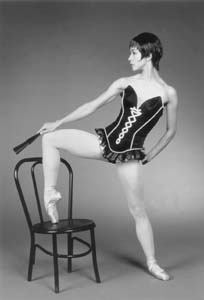![[Metroactive Stage]](/stage/gifs/stage468.gif)
[ Stage Index | San Jose | Metroactive Central | Archives ]
Photograph by John Gerbetz
Black Leather Ballet
SJ Cleveland Ballet turns up the heat with a new take on Roland Petit's scandalously sexy ballet 'Carmen'
By Traci Hukill
ON FEB. 21, 1949, Carmen, the ballet, premiered at the Prince's Theatre in London and sent ripples of scandal through the international theater scene. The ballet, danced to portions of the hypnotic, myrrh-scented opera score by Georges Bizet, distilled the south Spanish tale of the lusty Gypsy Carmen and her lover Don José into 45 erotically charged minutes, articulating in mute movement what the words in the opera libretto only hinted at.
It seems the ballet had something to shock everyone. Dancers clad in revealing outfits prowled around the stage smoking cigarettes. In one scene, a couple in the background made love, arching and undulating to the most erotic choreography ever seen in a ballet. Carmen and Don José's explicit liaison sealed it. In Carmen, ballet theater broke away from the dainty ballerina-as-bird formula and gave theatergoers an earthy heroine whose passion for life ignited everything she touched.
The Canadians banned Carmen as pornography. The French press scalded the show, infuriated by the thought of a French opera thus defiled. Tickets flew out of the box office so fast that by the time the show arrived in Paris, home of the performing company, there were none to be found. And choreographer Roland Petit found himself launched into a career orbit that would take him to the country of stars and beyond.
The 25-year-old dancer and choreographer had already made something of a name for himself, having studied at the Paris Opera Ballet and left at age 21 to start the Ballets des Champs Elysées with several luminaries of the dance world, including writer and director Jean Cocteau.
With Petit's subsequent founding of Les Ballets de Paris, he became a star dancer and choreographer and began seriously exploring his own style. The theatrical flair that eventually came to typify his creations had its first blossoming in Carmen.
Petit went on to choreograph a number of Hollywood movies, in which his taste for elaborate sets and costumes was fully indulged. Among his projects were Daddy Long Legs (1955), starring Fred Astaire, and Anything Goes (1956), with Bing Crosby. Eventually, Petit worked his way back to France and created the Ballets de Marseilles in 1972. He has remained there ever since.
Now 76, Petit is still working hard and is living to see his earlier works come back into fashion. His storytelling, star-making ballets with their richly nuanced roles fell out of style with the advent of more abstract works. But a growing corps of directors is reaching back into the treasure trove of earlier ballets that can captivate the imaginations of modern viewers. Petit's are among them, and they are coveted.
But Petit won't allow just anyone to perform his ballets. His stringent standards are legendary--only five companies have ever been allowed to perform Carmen. The only American company to do so is the American Ballet Theater, which mounted a production in 1981 with Mikhail Baryshnikov as Don José. That puts San Jose Cleveland Ballet in quite a rarified atmosphere.
Says Diane Kounalakis, associate director of public relations for San Francisco Ballet, "Petit's sought after, but he's very difficult to get. I think it says a lot about San Jose Cleveland. They're starting to acquire some very significant works."
'IT'S A LANDMARK BALLET for sure," says Dennis Nahat, director of the San Jose Cleveland Ballet. He is speaking from Cleveland, where he has just finished a day of rehearsal. "It created a whole new way of looking at dance when it was done. It was so ahead of its time. I think it still is in its content [and] its presentation. It's still choreography that a lot of people can't even do today."
The dance's flavor is distinctly modern, a showcase for grand, slicing gestures, a ballet in black leather. The metallic taste of existentialism lurks in every scene, lending the dance an eerie realism. The characters are cynical and discontented, and in the dramatic climax is the suggestion that Carmen herself has always known this moment would come and so embraces her fate. But this is no stark and pessimistic work; Carmen nurses a romantic's addiction to lavish sets and costumes.
Nahat thinks his own appreciation for the show's extravagance worked in his favor. Last year, Nahat and Petit met for lunch near the opera house in Paris to discuss the potential of San Jose Cleveland Ballet's licensing of the piece. There came a point in the conversation when Nahat felt he was being tested.
Petit had asked him how he would do Carmen--with pared-down scenery or costumes, or "with everything." Nahat answered that he wanted to use Petit's original flamboyant concept. Asked if he thinks he would have gotten Petit's blessing if he'd answered otherwise, Nahat doesn't hesitate.
"I doubt it. He's never done a simpler version."
So back to Cleveland Nahat went, French set designers and costume makers in tow. And the company began the difficult work of rehearsals.
CUBAN-BORN Anna Lobe (who starred in the company's production of Blue Suede Shoes last year), is enjoying the process of learning the complex role of Carmen.
"It completely fits my personality," she says. "The music inspires me a lot, and I love the role, the passion. She does whatever she wants. She likes to do things her way, and she likes to flirt. She's so strong that she made a man to kill for her." Lobe laughs. "So she's Carmen."
A régisseur, or ballet master, sent by Petit is on hand at every rehearsal to ensure that the choreography remains true to the original. Working within the boundaries set by Petit's choreography while also finding a way to breathe life into the patterns of movement laid out before her is a pleasurable challenge, Lobe says.
"I have to find my own Carmen, but I can't go out of what he says," she explains. "More than anything, I use the music for an interpretive role." She listens to the tape every day during her 45-minute commute to and from her day-long rehearsals to deepen her understanding of the role.
Amazingly, the 35-year-old dancer gave birth to a baby girl last July and was back to teaching classes and practicing within six weeks. It was no small trick.
"The hardest thing is you lose all the muscle tone in your body," she admits. "In general, the body kind of relaxes for the birth. I'm a very muscular person, and I've never been out of shape, so for me it was like, 'Wow!' It was a little hard at the beginning. You send information to the muscles, and they don't respond."
Pixieish and taut, with short-cropped hair and delicate features, Anna in her Carmen corset costume looks a far cry from the tutu-ruffled, alabaster-skinned ballerina of Degas' paintings and cultural imagination. But that's part of the appeal of Carmen, says Nahat. It delivers the unexpected.
"The music, for one, is extraordinary," he says. "And it's a very alluring role. She's a fantasy, probably, for a lot of women--a free spirit. She goes about her business and has her own mind. Unfortunately, it's a tragedy. But I think the main attraction with Carmen is its love and hate playing on the edge of life, living dangerously."
The story of Carmen comes from a novella by Prosper Mérimée. Set in the southern Spanish town of Seville, it's the story of a strong-willed, sensuous Gypsy and her friends, who are essentially a band of thieves.
Don José, an upstanding officer and something of an innocent, comparatively, falls in love with Carmen upon seeing her whaling the tar out of another woman. Their torrid affair leads him into the dark heart of Carmen's seedy world when she convinces him to kill a man so she can rob him more conveniently. In the end, however, a handsome toreador comes to town, and Carmen loses interest in Don José, who reacts with a rage that lights tragedy in its wake.
"You put the French and the Spaniards together and what have you got?" Nahat asks rhetorically. "A lot of heat onstage."
Carmen, with its reorchestrated score by David Garthforth, is the final piece in a triptych that Nahat describes as "a perfect program you die and wait for" as a ballet aficionado. Beginning the evening is Nahat's own Mendelssohn Symphony, set to Felix Mendelssohn's Fourth Symphony. A contemporary work undertaken in the classical style, the piece progresses through four movements that culminate in a lively dance called a saltarello.
The second work is George Balanchine's The Four Temperaments, an abstract work in five parts that pivots on the four psychological and physical types of Greek and medieval medicine: melancholic, sanguinic, phlegmatic and choleric. The music is by Paul Hindemith accompanies dancers who are simply clothed in black leotards and pink tights.
And then there's Carmen, the "pièce de résistance," as Nahat says.
Times have changed, and so has the definition of "risqué." Nevertheless, the winter newsletter of San Jose Cleveland Ballet proudly announces the company premiere of Carmen with this caveat: "Carmen contains scenes of violence and explicit sexual choreography. It is recommended for mature audiences ONLY!"
And highly recommended to anyone who wants to see a passionate ballet by a legendary choreographer.
[ San Jose | Metroactive Central | Archives ]
![]()
 She Does It Her Way: Dancer Anna Lobe loves the passion of her character, Carmen.
She Does It Her Way: Dancer Anna Lobe loves the passion of her character, Carmen.
 Storyteller: Modern companies are beginning to revive the richly nuanced works of Roland Petit.
Storyteller: Modern companies are beginning to revive the richly nuanced works of Roland Petit.
San Jose Cleveland Ballet presents Mendelssohn Symphony, The Four Temperaments and Carmen Feb. 24-27 at San Jose Center for the Performing Arts; Thursday and Sunday at 7:30pm, Friday-Saturday at 8pm, Sunday at 1:30pm. Tickets are $18-$60. (408.288.2820)
From the February 17-23, 2000 issue of Metro, Silicon Valley's Weekly Newspaper.